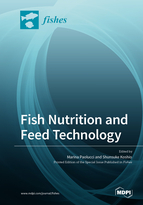Fish Nutrition and Feed Technology
A special issue of Fishes (ISSN 2410-3888). This special issue belongs to the section "Nutrition and Feeding".
Deadline for manuscript submissions: closed (31 October 2022) | Viewed by 49792
Special Issue Editors
Interests: animal nutrition; feed manufacturing; animal product shelf-life; bioactive molecules; biopolymers
Special Issues, Collections and Topics in MDPI journals
Special Issue Information
Dear Colleagues,
The rapid growth of modern aquaculture reflects the future of our planet and people. As the global population and demands for seafood increase, it is clear that we must develop sustainable aquaculture to supplement wild-caught seafood products.
As aquafeed is one of the most significant factors for successful sustainable aquaculture, it is important to understand fish nutrition and apply this knowledge to the latest feed technologies. Since the 1960s, the research on the abovementioned areas has rapidly progressed in many ways; therefore, there is a need to consolidate the latest information regarding aquaculture development.
This Special Issue aims to provide the latest information on fish nutrition and feed technology to develop sustainable aquafeeds. Submissions may take the form of original research, full or mini-reviews, and perspectives on topics including, but not limited to, the following:
- Fish nutrition, or more generally for aquatic animals;
- The evaluation of test ingredients and practical diets for cultured species;
- The evaluation of functional supplements to improve the nutritional value of aquafeed;
- Metabolic pathways of nutrients, including gene expression, for aquatic animals;
- New technology for aquafeed production systems;
- The evaluation of newly introduced feed production technology.
Prof. Dr. Marina Paolucci
Prof. Dr. Shunsuke Koshio
Guest Editors
Manuscript Submission Information
Manuscripts should be submitted online at www.mdpi.com by registering and logging in to this website. Once you are registered, click here to go to the submission form. Manuscripts can be submitted until the deadline. All submissions that pass pre-check are peer-reviewed. Accepted papers will be published continuously in the journal (as soon as accepted) and will be listed together on the special issue website. Research articles, review articles as well as short communications are invited. For planned papers, a title and short abstract (about 100 words) can be sent to the Editorial Office for announcement on this website.
Submitted manuscripts should not have been published previously, nor be under consideration for publication elsewhere (except conference proceedings papers). All manuscripts are thoroughly refereed through a single-blind peer-review process. A guide for authors and other relevant information for submission of manuscripts is available on the Instructions for Authors page. Fishes is an international peer-reviewed open access monthly journal published by MDPI.
Please visit the Instructions for Authors page before submitting a manuscript. The Article Processing Charge (APC) for publication in this open access journal is 2600 CHF (Swiss Francs). Submitted papers should be well formatted and use good English. Authors may use MDPI's English editing service prior to publication or during author revisions.







